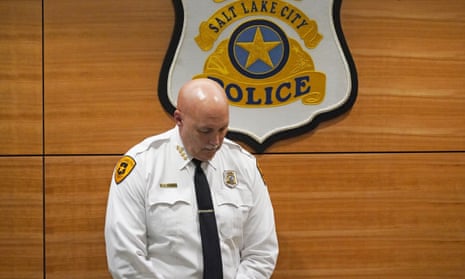A 13-year-old Utah boy with autism was shot by police after his mother asked for help getting him hospital mental health treatment and officers agreed to talk with him, police footage released Monday showed.
The videos show Salt Lake City officers chasing him down an alley after they arrive at his home, then yelling at him to get on the ground. The boy collapses after about 11 shots ring out. He survived but suffered broken bones and pierced organs, the family’s attorney has said. He remains hospitalized.
His mother, Golda Barton, had warned police that her son said earlier that day, 4 September, that he had a gun and had threatened to shoot her male coworker and break windows in the house, the video showed. But she told officers she thought it was a BB gun or pellet gun. There were no indications he was armed.
She wanted him to be hospitalized for help with his mental health issues.
Officers said they would have to proceed as though the boy did have access to a real gun, the videos show. Barton told officers the boy was “triggered” by seeing police.
“He sees the badge and he automatically thinks you are going to kill him or he has to defend himself in some way,” she said. “He freaks out.”
The video was made public under a Salt Lake City ordinance requiring the release of video from police shootings within 10 business days.
The shooting has raised new questions about how police deal with people with mental health issues amid nationwide calls for police reform. It came hours before new de-escalation tactics were due to take effect for Salt Lake City police, which is cooperating with an independent investigation of the shooting.
In one video, two officers can be heard discussing whether to approach the boy because they were concerned that the incident would result in a shooting. As officers approach the house, one says he can see movement in the backyard. The officers start to run after the boy, yelling at him to stop and get on the ground. When they catch up, they ask him to get on the ground again. The boy continues walking before a series of shots ring out.
The videos do not seem to show the boy holding any weapon and police do not mention any in a report, also released Monday. Barton has said she told dispatchers her son was having a breakdown and she needed help from a crisis-intervention officer.
On the 911 recording, she says she has called the cops before on her son and that he has previously run away from officers. “My biggest fear is that, I don’t know, I just don’t want him to die,” Barton said.
She adds: “That’s why we need a mental health worker … It’s super important.” The officers who arrived had some mental health training but were not specialists in crisis intervention.
Linden, whom the family wants identified only by his first name, “was lucky to be alive”, his attorney, Zach Weyher, said.
“Whatever happened, it was a 13-year-old boy who was unarmed. The police were called for a mental-health call, not a criminal act,” Weyher said. “A child is laying in a hospital bed ... there has to be a better response.”
The mayor of Salt Lake City, Erin Mendenhall,called for a quick but thorough investigation at a news conference on Monday.
“I am profoundly heartbroken and frustrated,” she said. “It’s a tragedy for this young boy, for his mother and for families and individuals who have acute mental health needs.”
